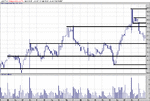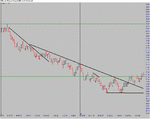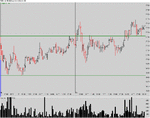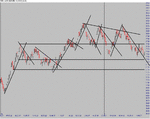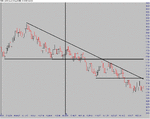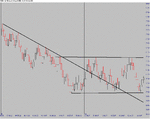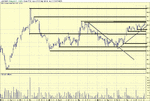http://wallstreetwindow.com/weinstein.htm
"Stocks form bottoms when the current news is terrible and top out when the public is ecstatic about glowing earnings reports, stock splits, and so on. It’s therefore not surprising that typical traders and investors buy near the top, when the news is great, and then dump their stock for big losses, near the low, when the media are reporting ghastly news. It’s not luck (good or bad) that causes consistent losses for the public and consistent profits for the real professionals, but the rules by which the two groups are playing. It’s really no different from a professional poker player who understands the odds and refuses to pull to an inside straight, while the amateur lets his hunches and feelings lead him into losses."
Weinstein’s breaks a stock’s life cycle up into 4 phases:
1 – Share Accumulation / Basing
2 – Mark Up / Rising Prices
3 – Share Distribution / Topping
4 – Share Liquidation / Declining Prices
Each of these four phases is characterized by a distinct pattern caused by the free market forces of supply and demand. In some phases, buyers have the upper hand and in other phases, sellers do.
As an investor, you do not want to own a stock that is in liquidation. Nor do you want to buy a stock that is topping out. By understanding the life cycle of stock chart patterns you will be able to know when it is best to buy a stock and when you should sell it.
Phase One – Accumulation / Basing
During the accumulation or basing phase, shares of a stock are transferred from weak hands to strong hands. This phase usually happens after a long decline or a lengthy advance. The stock trades in a very narrow range and appears to be dead money to the average investor.
They are correct to a certain degree, because - during this phase - the forces of supply and demand are roughly equal. Although there is no big buying excitement, there are no waves of sellers either. During this time, the average investor often sells out of fear that the stock will drop further or he/she sells because of impatience.
The stock market discounts the future. The market does not move based on today’s news, but on perceptions on what the future of the economy and business prospects will be. This is true with individual stocks also. The smart money, insiders and institutions, are the first to realize that a company’s prospects are brightening. Towards the end of the basing phase they begin to heavily accumulate the company’s stock. Often, although not always, the stock’s trading volume will pick up towards the end of this phase and large 'big block' purchases will take place.
A trading range defines the price action in a base. Stocks that are basing bounce between a specific high and low price zone. Sellers often wait for the stock to go to the top of its range before they sell. By doing this they create an area of resistance, a price level the stock cannot trade through. When it reaches resistance it repeatedly falls back down. The more often it does this, the stronger the resistance. The basing phase lasts as long as resistance holds and the stock remains stuck in its trading range. As a general rule the longer this phase lasts the longer the second phase will last.
Phase Two – Mark Up / Rising Prices
If the smart money continues to accumulate shares they will eventually run out of sellers to buy from. At this point, resistance gets taken out and the stock price clears its base. Bulls get the upper hand with the stock, not because there are suddenly more buyers interested in the stock, but because the sellers have disappeared.
Often - at the moment the stock breaks out of its basing phase - the fundamentals of a company are poor. However, even though this is the best time to buy a stock most analysts will be down on the stock and consequently your stockbroker will probably try to talk you out of buying.
But remember, the smart money buyers and stock prices themselves, are anticipating a positive future. You are always better off following their lead than the opinions of Wall Street analysts and most stockbrokers.
As demand outpaces supply, institutions and insiders will compete with one another to buy the stock. Their psychology begins to change. During the basing phase they bought on dips, now they do not mind buying as the stock price advances.
As the advance continues, eventually word gets out that the fundamentals of the company are improving or some positive development concerning the company becomes common knowledge. As this happens, the average investor and the general public becomes interested in the stock and begin to buy too. Analysts begin to put the stock on their recommendation lists.
Phase Three - Share Distribution / Topping
Eventually the stock gets ahead of itself and stops advancing. Perhaps the growth prospects for the company no longer look so grand. Or the stock has simply reached a high valuation. Whatever the case may be, at this point insiders and institutions decide that it is time to sell and take profits.
They find plenty of willing buyers. In fact the news is often so good about the company that people are willing to pay any price for the stock. They saw it climb during its stage of rising prices and believe that it will keep going up. Analysts say it will and so do their brokers. Almost everyone is positive about the company.
Everyone that is, but the smart money sellers who know better. Although they carefully sell into rallies so as not to cause the stock price to collapse, the stock begins to flatten out and move sideways as it bounces off of new resistance and support levels. It trades in a range, just like it did during the basing phase, but with greater volatility and price swings. In this phase, though, the smart money is distributing their shares instead of accumulating them from other people.
This phase lasts as long as the selling and buying pressure remain equal. Once the buyers become exhausted the stock will break below its trading range and begin its liquidation phase, which is characterized by sharply falling prices.
Phase Four - Liquidation / Falling Prices
While a stock is being distributed and is topping out after a lengthy price advance, big players sell into rallies while the remaining true believers try to buy dips. After the demand for the stock becomes exhausted, sellers overtake buyers and no longer wait to unload their shares on rallies.
Despite the falling prices at the beginning of this stage the average investor remains bullish about the stock and believes the pullback is nothing but a temporary correction. The good news and business fundamentals have likely just reached their peak and the stock is still considered a hot issue by most analysts and stockbrokers. Buyers mistakenly believe that the stock is now cheap because it has dropped and become obsessed with trying to guess the bottom, thinking that the stock will return to its lofty price highs.
In fact, the longer and greater the price advance in stage two the more popular the stock will remain during the beginning of the stage four decline. However, buyers in stage four become bagholders for the smart money sellers.
Stage four begins with the average investor full of hope, then holding in disbelief, and finally selling near the bottom in outright panic.
Most people think that stocks bottom when prices get so cheap that institutions and big money start to buy and that tops happen when all of a sudden people start to sell. Things don't exactly work like that.
Stock market Phase 4 declines end, not when big money buyers come in to support the stock, but when every last bagholder has sold in a panic. Basically, since there are no more sellers left, the stock begins to hold its ground - and thus the cycle repeats itself starting over with Phase One - Accumulation / Basing.
This why you get a final wave of panic selling. All the average investors who bought on hope throw in the towel in a final burst of panic. And since there is no one left to sell, and likely not many buyers interested - you get the sideways basing action that is characteristic of stage 1.
The most profitable time to buy into a stock is at the end of the stage one – which just happens to be the time of the heaviest insider interest. This is the most profitable chart pattern I know. It allows you to actually buy in low – with the insiders – and sell high when the general public, who knows very little, will willingly buy your shares and play the role of the greater fool.
Having this knowledge and putting it to use in the market is, in my opinion, worth more in actual $$$ than any degree you could possibly get from a University. Let's all make a resolution to put it to good use this year


